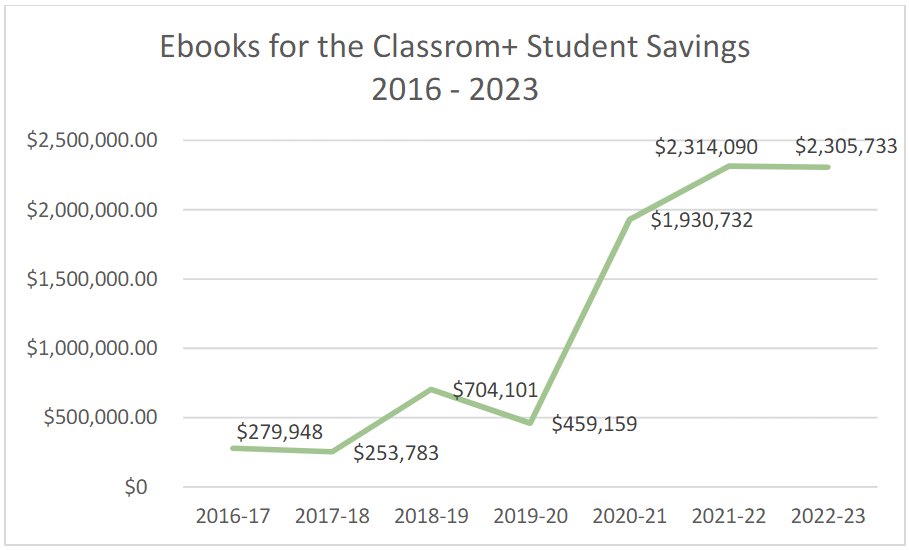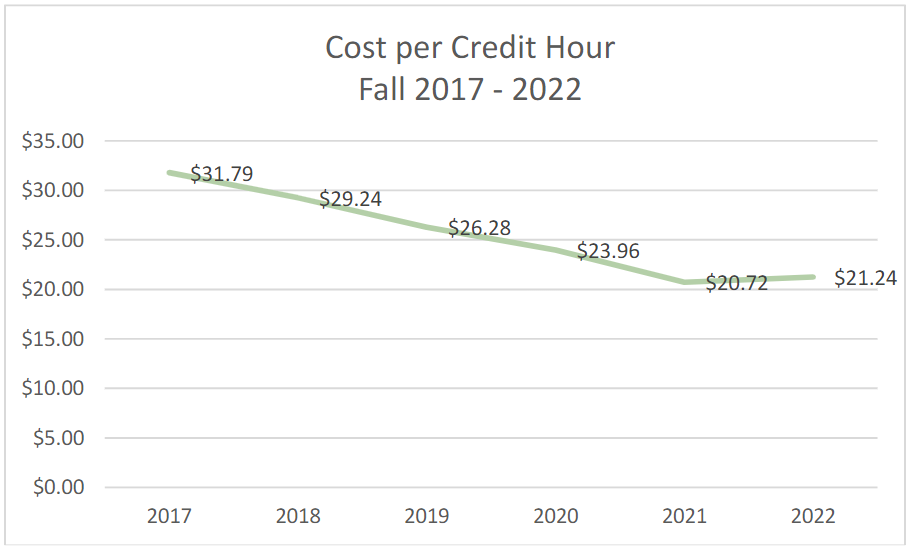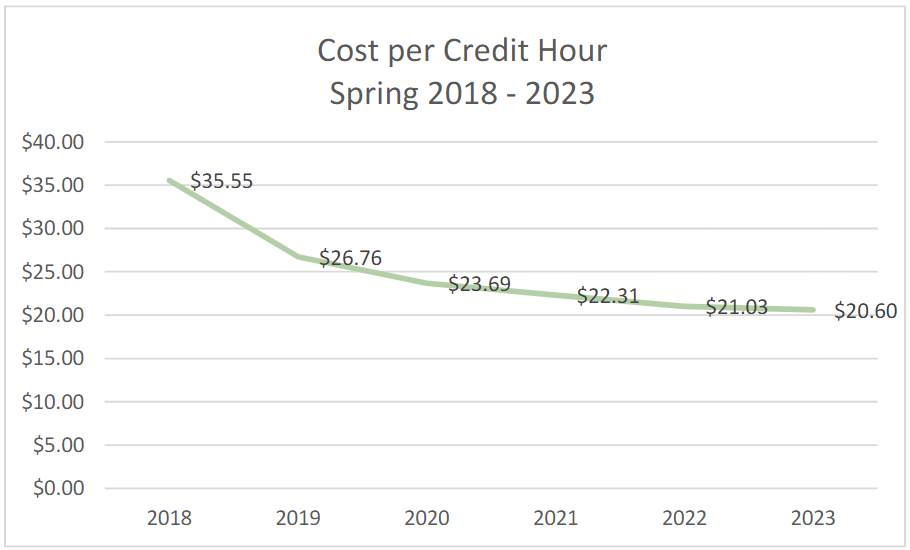Guest Post by Alex Neff, Director of Data Analytics and Textbook Affordability (DATA) at USF Libraries
Building upon the previous post on Florida’s textbook affordability environment, this entry will cover several of the most popular initiatives implemented by the Textbook Affordability Project (TAP) at the University of South Florida (USF) Libraries. For more than a decade, these initiatives yielded substantial benefits for students, faculty, and the institution as a whole by significantly reducing the financial burden associated with acquiring course materials. Over $40 million worth of student textbook savings have resulted from the initiatives implemented by TAP.
Established in 2009, the Ebooks for the Classroom+ (EB+) initiative has been committed to fulfilling faculty requests for ebook licenses through the USF Libraries, ensuring that students on every USF campus have access to required or recommended readings at no cost when possible. In 2017, the program underwent a transformation with the addition of the EB+ database tool, boasting an extensive collection of over 700,000 ebooks available for adoption in USF courses. Faculty at USF can use the tool to seamlessly request and integrate library-supplied ebooks from EB+. The licensed ebooks come with minimal restrictions on use, such as printing, downloading, and simultaneous usage, making them a convenient and free alternative to traditional textbooks. Consequently, students have immediate access to materials at no cost to them. This initiative has had a great impact on textbook affordability at USF, giving students immediate access to course materials at no cost to them and ultimately saving over 125,000 students a cumulative total of $8.2 million from 2016 to 2023.

Since 2018, TAP analyzed undergraduate textbook adoptions submitted to the USF Bookstore from preceding semesters as part of the Textbook Recommendation Service initiative. In addition to raising faculty awareness about digital textbook options, Inclusive Access affordability programs, library resources, and open access textbooks, the initiative’s ultimate goal was to aid academic departments and their library liaisons in identifying more affordable options based on prior textbook selections to assist in reducing USF’s average textbook cost per credit hour.
Comparing the fall semesters from 2017 through 2022, the cost per credit hour average cost of textbooks for undergraduate courses decreased 33% from $31.79 to $21.24.

Comparing the spring semesters from 2018 through 2023, the cost per credit hour average cost of textbooks for undergraduate courses decreased 42% from $35.55 to $20.60.

TAP has encouraged open access textbook adoptions at USF through the Textbook Recommendation Service, actively researching and advocating for faculty to include open education resources (OERs) in supplemental course material lists or replace expensive textbooks. The utilization of OERs by faculty has led to significant outcomes, consistently resulting in annual student savings surpassing $2 million each year to a total of over $12 million since 2018.

A prime example of successful OER implementation at USF is evident through the USF Chemistry department’s commitment to textbook affordability. In fall 2018, prompted by participation in a Textbook Affordability Days event hosted by TAP, the Chemistry department transitioned all General Chemistry I & II courses to the OpenStax Chemistry open access textbook. This swift change, replacing a $300 textbook with one available for free, resulted in an immediate and substantial reduction in costs for students enrolled in these high-demand courses, generating more savings with each passing semester. Since fall 2018 and extending through spring 2023, the Chemistry department has provided over $10.4 million in savings for its students by embracing open access materials.
The TAP Toolbox was introduced in spring 2018 and integrated into the TAP website to offer helpful textbook affordability information to USF Faculty while fostering awareness about affordability issues. This toolbox provides a comprehensive range of resources and features, including a general overview of current challenges; a guide outlining best practices for faculty to maximize their affordability impact; State and USF regulations regarding textbook affordability; and a checklist of recommended steps for deans, department chairs/textbook coordinators, and instructors to review.
Annually, TAP receives an allocation of $30,000 from USF Auxiliary Funds to specifically purchase reserve copies of textbooks required for courses with high enrollments. These materials compose the TAP Course Reserves, which operates separately from and complements the standard USF Libraries Course Reserve, and are available for students to check-out on three-hour loans.
Affordability Counts emerged from Florida International University, aiming to commend faculty actively reducing student course material costs and promoting textbook affordability across universities and instructors statewide. Following its inception, TAP was requested to represent USF on the Affordability Counts Steering Committee to contribute to its advancement and success. The committee sought to create and maintain a comprehensive Florida-wide database showcasing affordable courses and materials adopted by instructors. Focusing on faculty with course material costs totaling $20 or less per credit hour, the initiative was designed to encourage submissions from eligible instructors. These submissions underwent review by the faculty member’s institution review team, verifying the information against syllabi and bookstore adoptions to ensure compliance. Approved faculty received the Affordability Counts medallion for display on course materials, signifying inclusion in the statewide database of low-cost courses and for facilitating the sharing of cost-effective resources among educators.
The Textbook Affordability Project at the USF Libraries significantly reduced the financial burden on students by implementing a range of initiatives over the past decade. With over $40 million in cumulative student savings, these efforts have led to a substantial decrease in the average cost per credit hour for textbooks and increased adoption of open educational resources across departments. By engaging faculty and assisting in the adoption of low-cost course materials, the USF Libraries is driving positive change and fostering a culture of inclusivity and student success in higher education.
Want to learn more?
Read the first post in the TAP series: TAP, Part I: Over a Decade of Textbook Affordability at USF